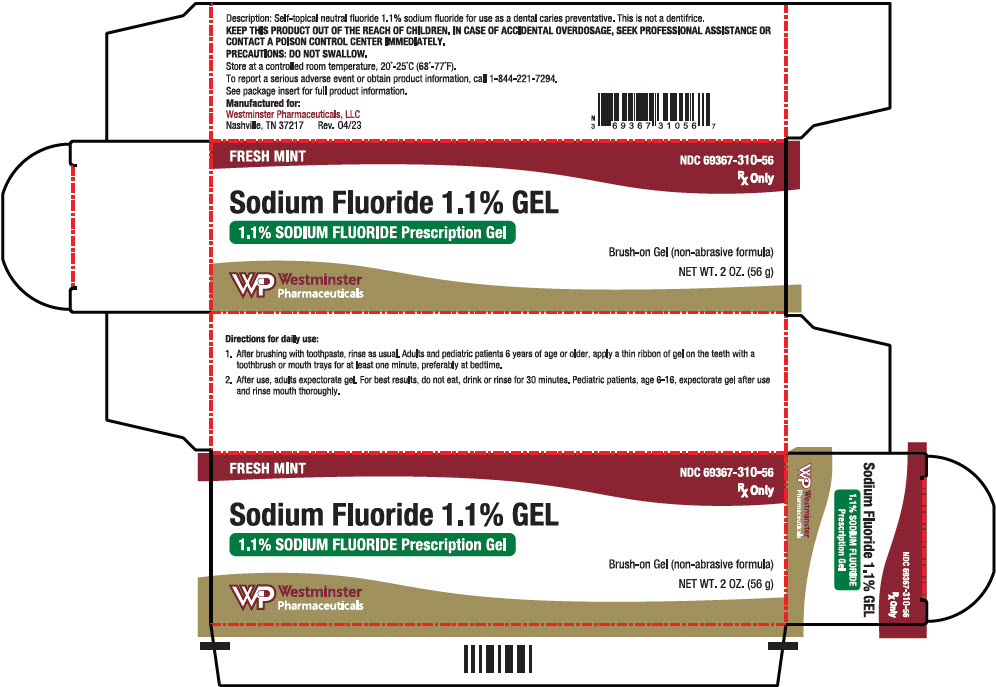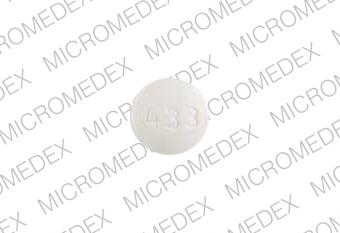Sodium Fluoride Dental Gel: Package Insert / Prescribing Info
Package insert / product label
Dosage form: gel
Drug class: Mouth and throat products
Medically reviewed by Drugs.com. Last updated on Aug 3, 2023.
On This Page
Sodium Fluoride Dental Gel Description
Self-topical neutral fluoride gel containing 1.1% (w/v) sodium fluoride for use as a dental caries preventive in pediatric patients and adults. This prescription product is not a dentifrice.
Active Ingredient: Sodium Fluoride, USP 1.1% (w/v).
Sodium Fluoride Dental Gel - Clinical Pharmacology
Frequent topical applications to the teeth with preparations having a relatively high fluoride content increase tooth resistance to acid dissolution and enhance penetration of the fluoride ion into tooth enamel.
Indications and Usage for Sodium Fluoride Dental Gel
A dental caries preventive, for once daily self-applied topical use. It is well established that 1.1% sodium fluoride is safe and extraordinarily effective as a caries preventive when applied frequently with mouthpiece applicators.1-4 SF 1.1% Brush-On Gel in a squeeze-tube is easily applied onto a toothbrush as well as a mouthpiece tray. This prescription dental gel should be used once daily following use of a regular toothpaste unless otherwise instructed by your dental professional. May be used whether or not drinking water is fluoridated since topical fluoride cannot produce fluorosis. (See WARNINGS for exception.)
Contraindications
Do not use in pediatric patients under age 6 years unless recommended by a dentist or physician.
Warnings
Prolonged daily ingestion may result in various degrees of dental fluorosis in pediatric patients under 6 years, especially if the water fluoridation exceeds 0.6 ppm, since younger pediatric patients frequently cannot perform the brushing process without significant swallowing. Use in pediatric patients under age 6 years requires special supervision to prevent repeated swallowing of gel which could cause dental fluorosis. Read directions carefully before using. If using a mouthpiece application, prolonged exposure (longer than 1 minute) may result in oral irritation, such as burning. KEEP THIS PRODUCT OUT OF THE REACH OF CHILDREN. IN CASE OF ACCIDENTAL OVERDOSAGE, SEEK PROFESSIONAL ASSISTANCE OR CONTACT A POISON CONTROL CENTER IMMEDIATELY.
Precautions
Not for systemic treatment. DO NOT SWALLOW.
Carcinogenesis, Mutagenesis, Impairment of Fertility
In a study conducted in rodents, no carcinogenesis was found in male and female mice and female rats treated with fluoride at dose levels ranging from 4.1 to 9.1 mg/kg of body weight. Equivocal evidence of carcinogenesis was reported in male rats treated with 2.5 and 4.1 mg/kg of body weight. In a second study, no carcinogenesis was observed in rats, males or females, treated with fluoride up to 11.3 mg/kg of body weight. Epidemiological data provide no credible evidence for an association between fluoride, either naturally occurring or added to drinking water, and risk of human cancer.
Fluoride ion is not mutagenic in standard bacterial systems. It has been shown that fluoride ion has potential to induce chromosome aberrations in cultured human and rodent cells at doses much higher than those to which humans are exposed. In vivo data are conflicting. Some studies report chromosome damage in rodents, while other studies using similar protocols report negative results.
Potential adverse reproductive effects of fluoride exposure in humans has not been adequately evaluated. Adverse effects on reproduction were reported for rats, mice, fox, and cattle exposed to 100 ppm or greater concentrations of fluoride in their diet or drinking water. Other studies conducted in rats demonstrated that lower concentrations of fluoride (5 mg/kg of body weight) did not result in impaired fertility and reproductive capabilities.
Pregnancy
Pregnancy Category B
It has been shown that fluoride crosses the placenta of rats, but only 0.01% of the amount administered is incorporated in fetal tissue. Animal studies (rats, mice, rabbits) have shown that fluoride is not a teratogen. Maternal exposure to 12.2 mg fluoride/kg of body weight (rats) or 13.1 mg/kg of body weight (rabbits) did not affect the litter size or fetal weight and did not increase the frequency of skeletal or visceral malformations. Epidemiological studies conducted in areas with high levels of naturally fluoridated water showed no increase in birth defects. Heavy exposure to fluoride in utero development may result in skeletal fluorosis which becomes evident in childhood.
Nursing Mothers
It is not known if fluoride is excreted in human milk. However, many drugs are excreted in milk, and caution should be exercised when products containing fluoride are administered to a nursing woman. Reduced milk production was reported in farm-raised fox when animals were fed a diet containing a high concentration of fluoride (98-137 mg/kg of body weight). No adverse effects on parturition, lactation, or offspring were seen in rats administered fluoride up to 5 mg/kg of body weight.
Pediatric Use
The use of SF 1.1% Brush-On Gel in pediatric age groups 6 to 16 years as a caries preventive is supported by pioneering clinical studies with 1.1% sodium fluoride gels in mouth trays in students are 11-14 years conducted by Englander, et al.2,3,4. Safety and effectiveness in pediatric patients below the age of 6 years have not been established. Please refer to the CONTRAINDICATIONS and WARNINGS sections.
Adverse Reactions/Side Effects
Allergic reactions and other idiosyncrasies have been rarely reported.
Overdosage
Accidental ingestion of large amounts of fluoride may result in acute burning in the mouth and sore tongue. Nausea, vomiting, and diarrhea may occur soon after ingestion (within 30 minutes) and are accompanies by salivation, hematemesis, and epigastric cramping and abdominal pain. These symptoms may persist for 24 hours. If less than 5 mg fluoride/kg body weight (i.e., less than 2.3 mg fluoride/lb body weight) have been ingested, give calcium (e.g., milk) orally to relieve gastrointestinal symptoms and observe for a few hours. If more than 5 mg fluoride/kg body weight (i.e., more than 2.3 mg fluoride/lb body weight) have been ingested, induce emesis, give orally soluble calcium (e.g., milk, 5% calcium gluconate or calcium lactate solution) and immediately seek medical assistance. For accidental ingestion of more than 15 mg fluoride/kg of body weight (i.e., more than 6.9 mg fluoride/lb body weight), induce vomiting and admit immediately to a hospital facility.
A treatment dose (a thin ribbon) of SF 1.1% Brush-On Gel contains 2 mg fluoride. A 2 oz. tube contains 266 mg fluoride.
Sodium Fluoride Dental Gel Dosage and Administration
Follow these instructions unless otherwise instructed by your dental professional: 1. After brushing thoroughly with toothpaste, rinse as usual. Adults and pedatric patients 6 years of age or older, apply a thin ribbon of gel to the teeth with a toothbrush or mouth trays once daily for at least one minute, preferably at bedtime. 2. After use, adults expectorate gel. For the best results, do not eat, drink, or rinse for 30 minutes. Pediatric patients, age 6-16, expectorate gel after use and rinse mouth thoroughly.
How is Sodium Fluoride Dental Gel supplied
2 oz. (56g) net wt. plastic tube.
Flavor: Fresh Mint
NDC 69367-310-56
References
1. American Dental Association, Council on Dental Therapeutics, Fluoride compounds, In: Accepted Dental Therapeutics, Ed. 40, Chicago, ADA, 405-407 (1984). 2. H.R. Englander et al., Clinical Anticaries Effect of Repeated Topical Sodium Fluoride Applications by Mouthpieces, JADA, 75, 638-644 (1967). 3. H.R. Englander et al., Residual Anticaries Effect of Repeated Topical Sodium Fluoride Applications by Mouthpieces, JADA, 78, 783-787 (1969). 4. H.R. Englander et al., Incremental Rates of Dental Caries After Repeated Topical Sodium Fluoride Applications in Children With Lifelong Consumption of Fluoridated Water, JADA, 82, 354-358, (1971).
You should call your doctor for medical advice about serious adverse events. To report a serious adverse event or obtain product information, contact Westminster Pharmaceuticals, LLC, 1-844-221-7294 or FDA at 1-800-FDA-1088 (Toll Free).
Manufactured for:
Westminster Pharmaceuticals, LLC
Nashville, TN 37217
Rev. 01/23
| SODIUM FLUORIDE 1.1% GEL
sodium fluoride gel |
||||||||||||||||||||
|
||||||||||||||||||||
|
||||||||||||||||||||
|
||||||||||||||||||||
|
||||||||||||||||||||
|
||||||||||||||||||||
|
||||||||||||||||||||
| Labeler - Westminster Pharmaceuticals, LLC (079516651) |
More about fluoride topical
- Compare alternatives
- Pricing & coupons
- Reviews (32)
- Drug images
- Side effects
- Dosage information
- During pregnancy
- Drug class: mouth and throat products
- En español
Patient resources
Professional resources
- 60 Second Fluoride Gel prescribing information
- Fluoride Foam (FDA)
- Sodium Fluoride Dental Cream (FDA)
- Sodium Fluoride Paste (FDA)
- Sodium Fluoride and Potassium Nitrate Gel (FDA)
- Stannous Fluoride Oral Rinse (FDA)
Other brands
Clinpro 5000, Prevident 5000 Plus, Fluoridex, PreviDent 5000 Booster, ... +37 more


